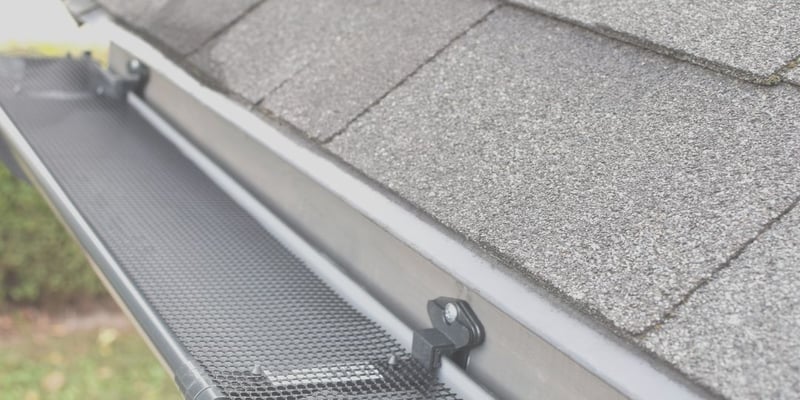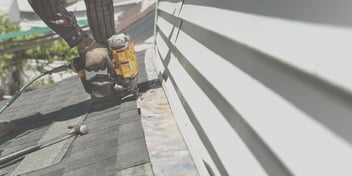- Home »
- Learningcenter »
- What is drip edge
What Is Drip Edge?

Part of understanding your home's roof is understanding its components. There are a lot of parts that make up your roofing system, and understanding what they are, what they do, and why they are important is one of the best steps you can take as a homeowner in keeping your roof in good condition. One crucial component of your roof is drip edge. But what is drip edge, what kinds are there, and what does it do?
What Is Drip Edge?
Drip edge is a crucial part of your roof's flashing system. The flashing system on your roof is strips of metal that protect your roof and direct water away from areas that would otherwise be prone to leaks. Drip edge, specifically, is a type of angled roof flashing installed at the edges of your roof. It plays an important role in keeping water off of your roof's flashing, and preventing water from getting underneath your roofing components.
Is Drip Edge Required?
Yes. Drip edge is actually required to be installed on your home for it to be up to code. The code that requires this is code R905.2.8.5. The code states that a drip edge shall be provided at the eaves and gables of all shingle roofs.
For your roof to be in compliance with code R905.2.8.5 drip edge not only needs to be installed on your roof, but it must be installed correctly and in accordance with the code.
In order for drip edge to be up to code, it states:
- Adjacent pieces of drip edge must be overlapped a minimum of 2 inches
- Drip edge must extend a minimum of .25 inches below the roof sheathing
- Drip edge must extend up the roof deck a minimum of 2 inches
- Drip edge must be mechanically fasted to the roof deck
- Underlayment must be installed over the drip edge on eaves
- Underlayment must be installed under the drip edge along gables
This may seem like a lot of rules for a little piece of metal! Drip edge is so crucial to the longevity of your roof, that following these parameters is a must. A good roofing contractor will know exactly how to install drip edge properly, and will take the utmost care when doing so to ensure your roof is in compliance will any and all applicable building codes.
What Kinds Of Drip Edge Are There?
Drip edge is typically made from a metal like aluminum, copper, or steel, and there are three main types. L drip edge, C drip edge, T drip edge, and F drip edge - these are all differentiated by their relative shapes. Though all types of drip edge perform the same function, the different shapes are suited to different roof types.
L Drip Edge
L-style drip edge is best suited to a low incline roof. It's an "L" shaped piece of metal, bent at 90 degrees. One side of the drip edge is placed underneath the roof, while the the other side comes down over the edge of the roof and protects the fascia from water.
C Drip Edge
C-style drip edge is best suited for roofs without fascia boards. This is a "C" shaped piece of metal that comes down over the roof's edge, and moves water away from both the roof and the home.
T Drip Edge
T-style drip edge is the best choice for homes in cold and snowy climates. This profile of drip edge is shaped like a “T,” with a lower flange at the bottom. This types of drip edge is popular amongst contractors, because it's the most effective at moving water off the roof and into the gutter, and it extends further than other types of drip edge, keeping water farther away from the roof.
F Drip Edge
F-style drip edge is typically the recommended style when you are adding drip edge to an existing roof. This style is also sometimes referred to as a "gutter apron". The "F" shape of the metal gives it a long top edge, which makes it easy to install over existing shingles.
Why Is Drip Edge Important?
The main purpose of dip edge is to direct water away from your roof, and subsequently your home, making it a crucial component of any roof. Drip edge serves many important functions, some of which include preventing damage to your soffit and fascia, keeping out water and pests by closing any gaps that may be present, hoping to guard against ice dams, keeping water away from your foundation, and preventing water from seeping under roof shingles.
As you can imagine, since drip edge plays so many important functions, it's critical that your roof not only has drip edge, but that is has drip edge that is the best fit for your home and has been properly installed by a professional roofing contractor.
Without drip edge, your home is vulnerable to all sorts of damage, including leaks, water damage to your soffit and fascia, pest invasion, and more.
Curious About Drip Edge?
If you're curious to learn more about drip edge, or to have it installed on your home, call us at Colony Roofers today! We offer free 30 minute inspections, where a member of our team will come out and fully assess your roof, and your roof's drip edge.We can help you make sure your drip edge is properly installed and up to code, and answer any questions you may have. Call us today!
 Call (678) 365-3138
Call (678) 365-3138


